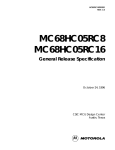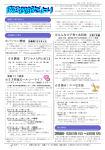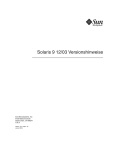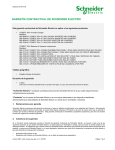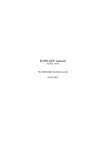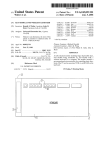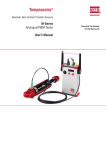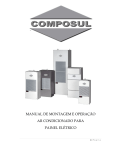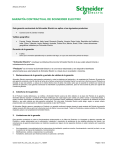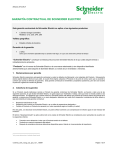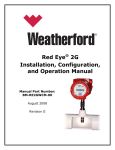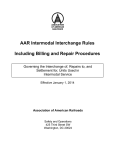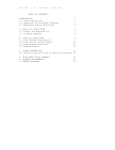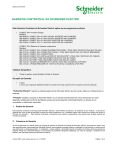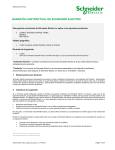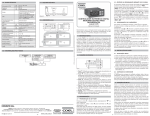Download Programming User`s Manual
Transcript
Programming User’s Manual Remote Controller SST65P542R ©2003 Silicon Storage Technology, Inc. S74004-00-000 4/03 1 The SST logo and SuperFlash are registered trademarks of Silicon Storage Technology, Inc. SoftPartition is a trademark of Silicon Storage Technology, Inc. These specifications are subject to change without notice. SST65P542R Programming Reference Manual TABLE OF CONTENTS 1.0 INTRODUCTION . . . . . . . . . . . . . . . . . . . . . . . . . . . . . . . . . . . . . . . . . . . . . . . . . . . . . . . . . . . . . . . . . . . . . . 4 2.0 BLOCK DIAGRAM . . . . . . . . . . . . . . . . . . . . . . . . . . . . . . . . . . . . . . . . . . . . . . . . . . . . . . . . . . . . . . . . . . . . . 5 3.0 PIN ASSIGNMENTS. . . . . . . . . . . . . . . . . . . . . . . . . . . . . . . . . . . . . . . . . . . . . . . . . . . . . . . . . . . . . . . . . . . . 6 4.0 MEMORY ORGANIZATION . . . . . . . . . . . . . . . . . . . . . . . . . . . . . . . . . . . . . . . . . . . . . . . . . . . . . . . . . . . . . . 7 5.0 MCU CORE AND INSTRUCTION SET . . . . . . . . . . . . . . . . . . . . . . . . . . . . . . . . . . . . . . . . . . . . . . . . . . . . . 8 5.1 Registers and Control Bit Assignments . . . . . . . . . . . . . . . . . . . . . . . . . . . . . . . . . . . . . . . . . . . . . . . . . . 8 5.1.1 5.1.2 5.1.3 5.1.4 5.1.5 Accumulator (A) . . . . . . . . . . . . . . . . . . . . . . . . . . . . . . . . . . . . . . . . . . . . . . . . . . . . . . . . . . . . . . . 9 Index Register (X) . . . . . . . . . . . . . . . . . . . . . . . . . . . . . . . . . . . . . . . . . . . . . . . . . . . . . . . . . . . . . 9 Program Counter (PC) . . . . . . . . . . . . . . . . . . . . . . . . . . . . . . . . . . . . . . . . . . . . . . . . . . . . . . . . . . 9 Stack Pointer (SP) . . . . . . . . . . . . . . . . . . . . . . . . . . . . . . . . . . . . . . . . . . . . . . . . . . . . . . . . . . . . . 9 Processor Status Word (PSW). . . . . . . . . . . . . . . . . . . . . . . . . . . . . . . . . . . . . . . . . . . . . . . . . . . 10 5.2 Addressing Modes . . . . . . . . . . . . . . . . . . . . . . . . . . . . . . . . . . . . . . . . . . . . . . . . . . . . . . . . . . . . . . . . . 10 5.2.1 Inherent (INH). . . . . . . . . . . . . . . . . . . . . . . . . . . . . . . . . . . . . . . . . . . . . . . . . . . . . . . . . . . . . . . . 5.2.2 Immediate (IMM) . . . . . . . . . . . . . . . . . . . . . . . . . . . . . . . . . . . . . . . . . . . . . . . . . . . . . . . . . . . . . 5.2.3 Direct (DIR) . . . . . . . . . . . . . . . . . . . . . . . . . . . . . . . . . . . . . . . . . . . . . . . . . . . . . . . . . . . . . . . . . 5.2.4 Extended (EXT) . . . . . . . . . . . . . . . . . . . . . . . . . . . . . . . . . . . . . . . . . . . . . . . . . . . . . . . . . . . . . . 5.2.5 Indexed, No Offset (IX). . . . . . . . . . . . . . . . . . . . . . . . . . . . . . . . . . . . . . . . . . . . . . . . . . . . . . . . . 5.2.6 Indexed, 8-bit Offset (IX1) . . . . . . . . . . . . . . . . . . . . . . . . . . . . . . . . . . . . . . . . . . . . . . . . . . . . . . 5.2.7 Indexed, 16-bit Offset (IX2) . . . . . . . . . . . . . . . . . . . . . . . . . . . . . . . . . . . . . . . . . . . . . . . . . . . . . 5.2.8 Relative (REL) . . . . . . . . . . . . . . . . . . . . . . . . . . . . . . . . . . . . . . . . . . . . . . . . . . . . . . . . . . . . . . . 5.2.9 Bit Set/Clear (BSC) . . . . . . . . . . . . . . . . . . . . . . . . . . . . . . . . . . . . . . . . . . . . . . . . . . . . . . . . . . . 5.2.10 Bit test and branch (BTB) . . . . . . . . . . . . . . . . . . . . . . . . . . . . . . . . . . . . . . . . . . . . . . . . . . . . . . 10 10 11 11 11 11 11 12 12 12 5.3 Instruction Set . . . . . . . . . . . . . . . . . . . . . . . . . . . . . . . . . . . . . . . . . . . . . . . . . . . . . . . . . . . . . . . . . . . . 13 6.0 I/O REGISTERS DEFINITION . . . . . . . . . . . . . . . . . . . . . . . . . . . . . . . . . . . . . . . . . . . . . . . . . . . . . . . . . . . 19 7.0 INTERRUPTS . . . . . . . . . . . . . . . . . . . . . . . . . . . . . . . . . . . . . . . . . . . . . . . . . . . . . . . . . . . . . . . . . . . . . . . . 22 8.0 RESETS AND CLOCKS . . . . . . . . . . . . . . . . . . . . . . . . . . . . . . . . . . . . . . . . . . . . . . . . . . . . . . . . . . . . . . . . 23 9.0 POWER-DOWN MODES . . . . . . . . . . . . . . . . . . . . . . . . . . . . . . . . . . . . . . . . . . . . . . . . . . . . . . . . . . . . . . . 24 9.1 STOP Mode . . . . . . . . . . . . . . . . . . . . . . . . . . . . . . . . . . . . . . . . . . . . . . . . . . . . . . . . . . . . . . . . . . . . . . 24 9.2 IDLE Mode . . . . . . . . . . . . . . . . . . . . . . . . . . . . . . . . . . . . . . . . . . . . . . . . . . . . . . . . . . . . . . . . . . . . . . . 24 ©2003 Silicon Storage Technology, Inc. S74004-00-000 2 4/03 SST65P542R Programming Reference Manual 10.0 THE CORE TIMER . . . . . . . . . . . . . . . . . . . . . . . . . . . . . . . . . . . . . . . . . . . . . . . . . . . . . . . . . . . . . . . . . . . . 25 10.1 Computer Operating Properly Watchdog Timer Control Register (CWTC) . . . . . . . . . . . . . . . . . . . . . 26 10.2 Timer Control and Status Register (TCSR) . . . . . . . . . . . . . . . . . . . . . . . . . . . . . . . . . . . . . . . . . . . . . 26 10.2.1 10.2.2 10.2.3 10.2.4 10.2.5 10.2.6 10.2.7 Core Timer Overflow (CTOF) . . . . . . . . . . . . . . . . . . . . . . . . . . . . . . . . . . . . . . . . . . . . . . . . . . . Real-Time Interrupt Flag (RTIF) . . . . . . . . . . . . . . . . . . . . . . . . . . . . . . . . . . . . . . . . . . . . . . . . . Timer Overflow Enable (TOFE) . . . . . . . . . . . . . . . . . . . . . . . . . . . . . . . . . . . . . . . . . . . . . . . . . Real-Time Interrupt Enable (RTIE). . . . . . . . . . . . . . . . . . . . . . . . . . . . . . . . . . . . . . . . . . . . . . . Timer Overflow Flag Clear (TOFC) . . . . . . . . . . . . . . . . . . . . . . . . . . . . . . . . . . . . . . . . . . . . . . Real-Time Interrupt Flag Clear (RTFC) . . . . . . . . . . . . . . . . . . . . . . . . . . . . . . . . . . . . . . . . . . . Real-Time Interrupt Rate Select (RT1-RT0). . . . . . . . . . . . . . . . . . . . . . . . . . . . . . . . . . . . . . . . 26 26 26 26 26 26 27 10.3 Core Timer Counter Register (CTCR) . . . . . . . . . . . . . . . . . . . . . . . . . . . . . . . . . . . . . . . . . . . . . . . . . 27 10.4 COP Watchdog Timer (CWT) Reset . . . . . . . . . . . . . . . . . . . . . . . . . . . . . . . . . . . . . . . . . . . . . . . . . . 27 10.5 Timer During IDLE Mode . . . . . . . . . . . . . . . . . . . . . . . . . . . . . . . . . . . . . . . . . . . . . . . . . . . . . . . . . . . 27 11.0 CARRIER MODULATOR TRANSMITTER (CMT) . . . . . . . . . . . . . . . . . . . . . . . . . . . . . . . . . . . . . . . . . . . . 28 11.1 Carrier Generator . . . . . . . . . . . . . . . . . . . . . . . . . . . . . . . . . . . . . . . . . . . . . . . . . . . . . . . . . . . . . . . . . 28 11.1.1 Time Counter . . . . . . . . . . . . . . . . . . . . . . . . . . . . . . . . . . . . . . . . . . . . . . . . . . . . . . . . . . . . . . . 29 11.1.2 Carrier Generator Data Registers (CHR1, CLR1, CHR2, and CLR2) . . . . . . . . . . . . . . . . . . . . 30 11.2 Modulator . . . . . . . . . . . . . . . . . . . . . . . . . . . . . . . . . . . . . . . . . . . . . . . . . . . . . . . . . . . . . . . . . . . . . . . 31 11.2.1 11.2.2 11.2.3 11.2.4 11.2.5 Time mode . . . . . . . . . . . . . . . . . . . . . . . . . . . . . . . . . . . . . . . . . . . . . . . . . . . . . . . . . . . . . . . . . FSK Mode . . . . . . . . . . . . . . . . . . . . . . . . . . . . . . . . . . . . . . . . . . . . . . . . . . . . . . . . . . . . . . . . . Extended Space Operation . . . . . . . . . . . . . . . . . . . . . . . . . . . . . . . . . . . . . . . . . . . . . . . . . . . . End Of Cycle (EOC) Interrupt. . . . . . . . . . . . . . . . . . . . . . . . . . . . . . . . . . . . . . . . . . . . . . . . . . . Modulator Period Data Register (MDR1, MDR2, and MDR3) . . . . . . . . . . . . . . . . . . . . . . . . . . 31 32 33 33 35 12.0 PROGRAMMING FLOW DIAGRAM. . . . . . . . . . . . . . . . . . . . . . . . . . . . . . . . . . . . . . . . . . . . . . . . . . . . . . . 36 13.0 PACKAGING DIAGRAMS . . . . . . . . . . . . . . . . . . . . . . . . . . . . . . . . . . . . . . . . . . . . . . . . . . . . . . . . . . . . . . 39 ©2003 Silicon Storage Technology, Inc. S74004-00-000 3 4/03 SST65P542R Programming Reference Manual 1.0 INTRODUCTION The SST65P542R is a member of SST’s 8-bit, application-specific microcontroller family targeting IR remote controller applications. The SST65P542R microcontroller provides high-functionality to infrared remote controller products. The device offers flexibility to store different remote control configurations for controlling multiple appliances. The configurations are either programmed at the factory during the manufacturing process or updated through a web download procedure using the serial interface. Using the SuperFlash nonvolatile memory technology, the SST65P542R enhances the functionality of the conventional universal remote controller devices by integrating multiple functions of a remote controller system in a single chip solution. The built-in LED I/O ports can directly drive LED indicators. The IR transmitter port drives signals to the infrared transmitter, which, in turn, remotely controls appliances. The SoftPartition flash memory architecture allows seamless partition of the program code, protocol tables, and user data in the small granularity of 128 Byte sectors. The small sector size and fast Erase/Write time greatly increase the time and power efficiency when altering the contents of the flash memory. The embedded controller is designed and manufactured using SST’s patented and proprietary SuperFlash EEPROM technology. SST’s highly reliable SuperFlash technology provides significant advantages over conventional flash memory technology. These advantages translate into significant overall cost savings and reliability benefits for customers. PRODUCT FEATURES • 8-bit MCU Core – Enhanced 6502 Microprocessor Megacell • 4 MHz Typical Oscillator Clock Frequency • 8 MHz maximum clock frequency • 16 KByte of user programmable flash memory • 352 Bytes SRAM • IR Input Pin for Learning Mode • Power-down Modes • Carrier Modulator Transmitter – Supports Baseband, Pulse Length Modulator (PLM), and Frequency Shift Keying (FSK) • Core Timer / Counter – 14-stage multifunctional ripple counter – Includes timer overflow, POR, RTI, and CWT • General Registers: – Accumulator (8-bit) – Index Register (8-bit) • Control registers: – Program Counter (16-bit) – Stack Pointer (16-bit / 6 addressable bits) – Condition code register (8-bit) • Addressing modes supported: 1. Immediate 3. Extended 5. Indexed, no offset 7. Indexed, 16-bit offset 9. Bit test and branch 2. Direct 4. Relative 6. Indexed, 8-bit offset 8. Bit set/clear 10. Inherent • Data types supported: 1. Bit data (manipulation instructions) 2. Byte data ©2003 Silicon Storage Technology, Inc. S74004-00-000 4 4/03 SST65P542R Programming Reference Manual 2.0 BLOCK DIAGRAM FUNCTIONAL BLOCK DIAGRAM Interrupt Control MCU Core SuperFlash EEPROM IRQ# RAM 352K x8 16K x8 Port A IRO Carrier Modulator Transmitter Port B Port C Timer/Counter Interrupt Real-Time Counter Core Timer / Counter COP Watchdog Timer 4004 B2.5 ©2003 Silicon Storage Technology, Inc. S74004-00-000 5 4/03 SST65P542R Programming Reference Manual 3.0 PIN ASSIGNMENTS PB0 PB1 PB2 PB3 PB4 PB5 PB6 PB7 PA0 PA1 PA2 PA3 PA4 PA5 1 2 3 4 5 6 7 8 9 10 11 12 13 14 28-pin SOIC 28 27 26 25 24 23 22 21 20 19 18 17 16 15 OSC1 OSC2 VDD IRQ# RESET# IRO VSS LPRST# PC3 PC2 PC1 PC0 PA7 PA6 4004 F10.1 FIGURE TABLE 3-1: PIN ASSIGNMENTS FOR 28-PIN SOIC 3-1: PIN DESCRIPTIONS Symbol Type1 16-9 PA[7:0] I/O1 Port A: The state of any pin in Port A is software programmable and every line is configured as an input during any external reset. 8-1 PB[7:0] I/O with internal pull-ups Port B: The state of any pin in Port B is software programmable and every line is configured as an input during any external reset. Each I/O line contains a programmable interrupt/pull-up for keyscan. PB[7] is used as a serial interface data line when the serial interface is enabled. 20-17 PC[3:0] I/O Port C: Every pin in Port C is a high-current pin and its state is software programmable. All lines are configured as inputs during any external reset. 23 IRO O IRO: Suitable for driving IR LED biasing logic, the IRO pin is the high-current source and sink output of the carrier modulator transmitter subsystem. Default state is low after any external reset. 21 LPRST# I Low-Power Reset: An active-low pin, LPRST# function sets MCU to low-power reset mode. The MCU, once in low-power reset mode, is held in reset with all processor clocks and crystal oscillator halted. An internal Schmitt trigger is included in the LPRST# pin to improve noise immunity. 24 RESET# I Reset: By setting the RESET# pin low the MCU is reset to a default state. An internal Schmitt trigger is included in the RESET# pin to improve noise immunity. 28 OSC1 I 27 OSC2 O Oscillator 1,2: These 2 pins interface with external oscillator circuits. A crystal resonator, a ceramic resonator, or an external clock signal can be used. 25 IRQ# I Interrupt Request: The IRQ# is negative edge-sensitive triggered. An internal Schmitt trigger is included in the IRQ# pin to improve noise immunity. 26 VDD I Power Supply: Supply Voltage 22 VSS I Ground: Circuit ground. (0V reference) Pins Name and Functions T3-1.5 4004 1. I = Input O = Output ©2003 Silicon Storage Technology, Inc. S74004-00-000 6 4/03 SST65P542R Programming Reference Manual 4.0 MEMORY ORGANIZATION The SST65P542R has a total of 64 KByte of addressable memory. A memory map is shown in Figure 4-1. The memory consists of 32 Bytes of I/O registers, 352 Bytes of SRAM, 16 KByte of user flash memory, and 128 Bytes of user vectors. 0180H I/O Registers Reserved CWT Reset 0000H 001FH 0020H 352 Bytes SRAM 3FF0H 017FH 0180H Reserved BFFFH BFFFH C000H User Memory Flash Memory (128 sectors) 127 Sectors (128 Bytes per sector) 16,256 Bytes Flash Memory FF80H Read Protection FF7FH FF80H Reserved User Vector FFF4H Reset and Interrupt Vectors FFFFH 4004 F11.3 FFFFH FIGURE 4-1: MEMORY MAP ©2003 Silicon Storage Technology, Inc. S74004-00-000 7 4/03 SST65P542R Programming Reference Manual 5.0 MCU CORE AND INSTRUCTION SET This section provides a description of the MCU core registers, the instruction set and the addressing modes. 5.1 Registers and Control Bit Assignments The MCU contains five registers, as shown in the programming model of Figure 5-1. The interrupt stacking order is shown in Figure 5-2. PROGRAM COUNTER STACK POINTER PCL PCH 0 0 0 0 0 0 0 0 SP 1 1 ACCUMULATOR INDEX REGISTER PSW REGISTER 1 1 1 H I N Z C Unused Unused Unused Half Carry Interrupt Disable Negative Zero Carry 4004 F01.4 FIGURE 5-1: PROGRAMMING MODEL ©2003 Silicon Storage Technology, Inc. S74004-00-000 8 4/03 SST65P542R Programming Reference Manual Unstacking increasing address PSW ACCUMULATOR (A) INDEX REGISTER (X) PCH PCL Stacking decreasing address FIGURE 4004 F02.3 5-2: STACKING ORDER Stacking decreases memory address and unstacking (Return) increases memory address. 5.1.1 Accumulator (A) The accumulator is a general purpose 8-bit register used to hold operands and results of an arithmetic calculation or data manipulations. 5.1.2 Index Register (X) The index register is an 8-bit register, which can contain the indexed addressing value used to create an effective address. The index register may also be used as a temporary storage area. 5.1.3 Program Counter (PC) The program counter is a 16-bit register, which contains the address of the next byte to be fetched. 5.1.4 Stack Pointer (SP) The stack pointer is a 16-bit register, which contains the address of the next free location on the stack. During an MCU reset or the reset stack pointer (RSP) instruction, the stack pointer is set to location 00FFH. The stack pointer is then decremented as data is pushed onto the stack and incremented as data is pulled from the stack. When accessing memory, the 8 most significant bits are permanently set to 00H. These eight bits are appended to the lower 8 significant register bits to produce an address within the range of 00C0H to 00FFH. Subroutines and interrupts may use up to 256 (decimal) locations. If 64 locations are exceeded, i.e. if stack pointer is pointing to 00C0H and stacking operation carried out, the stack pointer wraps around to 00FFH and overwrites the previously stored information. A subroutine call occupies two locations on the stack; an interrupt uses five locations. ©2003 Silicon Storage Technology, Inc. S74004-00-000 9 4/03 SST65P542R Programming Reference Manual 5.1.5 Processor Status Word (PSW) The PSW is a 5-bit register. These bits can be individually tested by a program, and specific actions can be taken as a result of their state. Each bit is explained in the following paragraphs. 5.1.5.1 Half Carry (H) This bit is set during ADD and ADC operations to indicate that a carry has occurred between bits 3 and 4 of the accumulator during an ADD or ADC operation. 5.1.5.2 Interrupt (I) When this bit is set all maskable interrupts are masked. If an interrupt occurs while this bit is set, the interrupt is latched and remains pending until the interrupt bit is cleared. After any reset, the interrupt mask is set and can be cleared by software instruction (CLI). 5.1.5.3 Negative (N) When set, this bit indicates that the result of the last arithmetic, logical, or data manipulation was negative. 5.1.5.4 Zero (Z) When set, this bit indicates that the result of the last arithmetic, logical, or data manipulation was zero. 5.1.5.5 Carry/Borrow (C) When set, this bit indicates that a carry or borrow out of the arithmetic logical unit (ALU) occurred during the last arithmetic operation. This bit is also affected during bit test and branch instructions and during shifts and rotates. 5.2 Addressing Modes Ten different addressing modes provide programmers with the flexibility to optimize their code for all situations. The various indexed addressing modes make it possible to locate data tables, code conversion tables and scaling tables anywhere in the memory space. Short indexed accesses are single byte instructions; the longest instructions (three bytes) enable access to tables throughout memory. Short absolute (direct) and long absolute (extended) addressing are also included. One or two byte direct addressing instructions access all data bytes in most applications. Extended addressing permits jump instructions to reach all memory locations. The term ‘effective address’ (EA) is used in describing the various addressing modes. The effective address is defined as the address from which the argument for an instruction is fetched or stored. The ten addressing modes of the processor are described below. Parentheses are used to indicate ‘contents of’ the location or register referred to. For example, (PC) indicates the contents of the location pointed to by the PC (program counter). An arrow indicates ‘is replaced by’ and a colon indicates concatenation of two bytes. 5.2.1 Inherent (INH) In the inherent addressing mode, all the information necessary to execute the instruction is contained in the opcode. Operations specifying only the index register or accumulator, as well as the control instruction, with no other arguments are included in this mode. These instructions are one byte long. 5.2.2 Immediate (IMM) In the immediate addressing mode, the operand is contained in the byte immediately following the opcode. EA = PC+1; PC ←PC+2 ©2003 Silicon Storage Technology, Inc. S74004-00-000 10 4/03 SST65P542R Programming Reference Manual 5.2.3 Direct (DIR) In the direct addressing mode, the effective address of the argument is contained in a single byte following the opcode byte. Direct addressing allows the user to directly address the lowest 256 bytes in memory with a single two-byte instruction. EA = (PC+1); PC ←PC+2 Address bus high byte ←0, Address bus low byte ←(PC+1) 5.2.4 Extended (EXT) In the extended addressing mode, the effective address of the argument is contained in the two bytes following the opcode byte. Instructions with extended addressing mode are capable of referencing arguments anywhere in memory with a single three-byte instruction. EA = (PC+1):(PC+2); PC ←PC+3 Address bus high byte ←(PC+1); Address bus low byte ←(PC+2) 5.2.5 Indexed, No Offset (IX) In the indexed, no offset addressing mode, the effective address of the argument is contained in the 8-bit index register. This addressing mode can access the first 256 memory locations. These instructions are only one byte long. This mode is often used to move a pointer through a table or to hold the address of a frequently referenced RAM or I/O location. EA = (X); PC ←PC+1 Address bus high byte ←0; Address bus low byte ←(X) 5.2.6 Indexed, 8-bit Offset (IX1) In the indexed, 8-bit offset addressing mode, the effective address is the sum of the contents of the unsigned 8-bit index register and the unsigned byte following the opcode. Therefore the operand can be located anywhere within the lowest 511 memory locations. This addressing mode is useful for selecting the mth element in an n element table. EA = (X)+(PC+1); PC ←PC+2 Address bus high byte ←K; Address bus low byte ←(X)+(PC+1) where K = the carry from the addition of (X) and (PC+1) 5.2.7 Indexed, 16-bit Offset (IX2) In the indexed, 16-bit offset addressing mode, the effective address is the sum of the contents of the unsigned 8-bit index register and the two unsigned bytes following the opcode. This address mode can be used in a manner similar to indexed, 8-bit offset except that this three-byte instruction allows tables to be anywhere in memory. As with direct and extended addressing, the assembler determines the shortest form of indexed addressing. EA = (X)+[(PC+1):(PC+2)]; PC ←PC+3 Address bus high byte ←(PC+1)+K; Address bus low byte ←(X)+(PC+2) where K = the carry from the addition of (X) and (PC+2) ©2003 Silicon Storage Technology, Inc. S74004-00-000 11 4/03 SST65P542R Programming Reference Manual 5.2.8 Relative (REL) The relative addressing mode is only used in branch instructions. In relative addressing, the contents of the 8-bit signed byte (the offset) following the opcode is sign-extended and added to the PC if, and only if, the branch conditions are true. Otherwise, control proceeds to the next instruction. The span of relative addressing is from -126 to +129 from the opcode address. The programmer need not calculate the offset when using the assembler, since it calculates the proper offset and checks to see that it is within the span of the branch. EA = PC+2+(PC+1); PC ←EA if branch taken; otherwise PC ←PC+2 5.2.9 Bit Set/Clear (BSC) In the bit set/clear addressing mode, the bit to be set or cleared is part of the opcode. The byte following the opcode specifies the address of the byte in which the specified bit is to be set or cleared. Any read/write bit in the first 256 locations of memory can be selectively set or cleared with a single two-byte instruction. EA = (PC+1); PC ←PC+2 Address bus high byte ←0; Address bus low byte ←(PC+1) 5.2.10 Bit test and branch (BTB) The bit test and branch addressing mode is a combination of direct addressing and relative addressing mode. The bit to be tested and its condition (set or clear) is included in the opcode. The address of the byte to be tested is in the single byte immediately following the opcode byte (EA1). The signed relative 8-bit offset in the third byte is signextended and added to the PC if the specified bit is set or cleared in the specified memory location. This single three-byte instruction allows the program to branch based on the condition of any readable bit in the first 256 locations of memory. The span of branch is from -125 to +130 from the opcode address. The state of the tested bit is also transferred to the carry bit of the condition code register. EA1 = (PC+1); PC ←PC+2 Address bus high byte →0; Address bus low byte →(PC+1) EA2 = PC+3+(PC+2); PC ←EA2 if branch taken; otherwise PC ←PC+3 ©2003 Silicon Storage Technology, Inc. S74004-00-000 12 4/03 SST65P542R Programming Reference Manual 5.3 Instruction Set Table 5-1 summarizes the MCU instruction set. A description of the instructions and an explanation of abbreviations follows the table on page 18. TABLE 5-1: MCU INSTRUCTION TABLE (1 OF 5) Address Mode (n) Hex Opcode Number of Machine Cycles Number of Bytes Flags Affected Add memory to accumulator with carry A+M+C →A IMM DIR EXT IX IX1 IX2 A9 B9 C9 F9 E9 D9 2 3 4 3 4 5 2 2 3 1 2 3 H–NZC ADD Add memory to accumulator A+M →A IMM DIR EXT IX IX1 IX2 AB BB CB FB EB DB 2 3 4 3 4 5 2 2 3 1 2 3 H–NZC AND “AND” memory with accumulator A&M →A IMM DIR EXT IX IX1 IX2 A4 B4 C4 F4 E4 D4 2 3 4 3 4 5 2 2 3 1 2 3 ––NZ– ASR Shift right one bit (accumulator or memory) b0 →C b7 held constant INH (A) INH (X) DIR IX IX1 47 57 37 77 67 3 3 5 5 6 1 1 2 1 2 ––NZC ASL (same as LSL) Shift left one bit (accumulator or memory) b7 →C 0 →b0 INH (A) INH (X) DIR IX IX1 48 58 38 78 68 3 3 5 5 6 1 1 2 1 2 ––NZC BCC Branch on carry clear Branch on C = 0 REL 24 3 2 ––––– BCLR Clear bit n BSC 11 + 2n 5 2 ––––– BCS Branch on carry set Branch on C = 1 REL 25 3 2 ––––– BEQ Branch on result zero Branch on Z = 1 REL 27 3 2 ––––– BHCC Branch if half carry clear Branch on H = 0 REL 28 3 2 ––––– BHCS Branch if half carry set Branch on H = 1 REL 29 3 2 ––––– BHI Branch if higher Branch if accumulator is higher than memory (unsigned) REL 22 3 2 ––––– Mnemonic Explanation ADC ©2003 Silicon Storage Technology, Inc. S74004-00-000 13 4/03 SST65P542R Programming Reference Manual TABLE 5-1: MCU INSTRUCTION TABLE (CONTINUED) (2 OF 5) Address Mode (n) Hex Opcode Number of Machine Cycles Number of Bytes Flags Affected REL 24 3 2 ––––– Mnemonic Explanation BHS Branch if higher or same Branch if accumulator is higher or same as memory (C = 0) BIH Branch if interrupt line is high REL 2F 3 2 ––––– BIL Branch if interrupt line is low REL 2E 3 2 ––––– BIT Tests bits in memory: A^M (logical compare) IMM DIR EXT IX IX1 IX2 A5 B5 C5 F5 E5 D5 2 3 4 3 4 5 2 2 3 1 2 3 ––NZ– BLO Branch if lower Branch if accumulator is lower Branch on REL 25 3 2 ––––– BLS Branch if low or same Branch if accumulator is lower than or equal to memory REL 23 3 2 ––––– BMC Branch if interrupt mask bit is clear REL 2C 3 2 ––––– BMI Branch if minus branch on N = 1 REL 2B 3 2 ––––– BMS Branch if interrupt mask bit is set Branch on I = 1 REL 2D 3 2 ––––– BNE Branch if not equal Branch on Z = 0 REL 26 3 2 ––––– BPL Branch if plus Branch on N = 0 REL 2A 3 2 ––––– BRA Branch always REL 20 3 2 ––––– BRN Branch never REL 21 3 2 ––––– BRCLR Branch if bit n is clear BTB 1 + 2n 5 3 ––––C BRSET Branch if bit n is set BTB 2n 5 3 ––––C BSET Set bit n BSC 10 + 2n 5 2 ––––– BSR Branch to subroutine REL AD 6 2 ––––– CLC Clear carry flag 0 →C INH 98 2 1 ––––0 CLI Clear interrupt mask bit 0 →I INH 9A 2 1 –0––– CLR Clear INH (A) INH (X) DIR IX IX1 4F 5F 3F 7F 6F 3 3 5 5 6 1 1 2 1 2 ––01– ©2003 Silicon Storage Technology, Inc. S74004-00-000 14 4/03 SST65P542R Programming Reference Manual TABLE 5-1: MCU INSTRUCTION TABLE (CONTINUED) (3 OF 5) Address Mode (n) Hex Opcode Number of Machine Cycles Number of Bytes Flags Affected Arithmetic compare memory and accumulator (unsigned) A-M IMM DIR EXT IX IX1 IX2 A1 B1 C1 F1 E1 D1 2 3 4 3 4 5 2 2 3 1 2 3 ––NZC COM Component (one’s complement) INH (A) INH (X) DIR IX IX1 43 53 33 73 63 3 3 5 5 6 1 1 2 1 2 ––NZ1 CPX Arithmetic compare memory and index X (unsigned) X-M IMM DIR EXT IX IX1 IX2 A3 B3 C3 F3 E3 D3 2 3 4 3 4 5 2 2 3 1 2 3 ––NZC DEC Decrement by one INH (A) INH (X) DIR IX IX1 4A 5A 3A 7A 6A 3 3 5 5 6 1 1 2 1 2 ––NZ– EOR “Exclusive or” memory with accumulator A ^ M →A IMM DIR EXT IX IX1 IX2 A8 B8 C8 F8 E8 D8 2 3 4 3 4 5 2 2 3 1 2 3 ––NZ– INC Increment by one INH (A) INH (X) DIR IX IX1 4C 5C 3C 7C 6C 3 3 5 5 6 1 1 2 1 2 ––NZ– JMP Jump to new location (PC + 1) →PCL (PC + 2) →PCH DIR EXT IX IX1 IX2 BC CC FC EC DC 2 3 2 3 4 2 3 1 2 3 ––––– JSR Jump to new location saving return address PC + 2↓ (PC + 1) →PCL (PC + 2) →PCH DIR EXT IX IX1 IX2 BD CD FD ED DD 5 6 5 6 7 2 3 1 2 3 ––––– Mnemonic Explanation CMP ©2003 Silicon Storage Technology, Inc. S74004-00-000 15 4/03 SST65P542R Programming Reference Manual TABLE 5-1: MCU INSTRUCTION TABLE (CONTINUED) (4 OF 5) Address Mode (n) Hex Opcode Number of Machine Cycles Number of Bytes Flags Affected Load accumulator with memory M →A IMM DIR EXT IX IX1 IX2 A6 B6 C6 F6 E6 D6 2 3 4 3 4 5 2 2 3 1 2 3 ––NZ– LDX Load index X with memory M →X IMM DIR EXT IX IX1 IX2 AE BE CE FE EE DE 2 3 4 3 4 5 2 2 3 1 2 3 ––NZ– LSL (same as ASL) Shift left one bit (accumulator or memory) b7 →C 0 →b0 INH (A) INH (X) DIR IX IX1 48 58 38 78 68 3 3 5 5 6 1 1 2 1 2 ––NZC LSR Shift right one bit (memory or accumulator) b0 →C 0 →b7 INH (A) INH (X) DIR IX IX1 44 54 34 74 64 3 3 5 5 6 1 1 2 1 2 ––0ZC MUL Multiplication X * A →X: A INH (A) 42 11 1 0–––0 NEG Negate (Two’s complement) INH (A) INH (X) DIR IX IX1 40 50 30 70 60 3 3 5 5 6 1 1 2 1 2 ––NZC NOP No operation INH 9D 2 1 ––––– ORA “OR” memory with accumulator A | M →A IMM DIR EXT IX IX1 IX2 AA BA CA FA EA DA 2 3 4 3 4 5 2 2 3 1 2 3 ––NZ– ROL Rotate one bit left through carry (memory or accumulator) INH (A) INH (X) DIR IX IX1 49 59 39 79 69 3 3 5 5 6 1 1 2 1 2 ––NZC ROR Rotate one bit right through carry (memory or accumulator) INH (A) INH (X) DIR IX IX1 46 56 36 76 66 3 3 5 5 6 1 1 2 1 2 ––NZC RSP Reset stack pointer INH 9C 2 1 ––––– RTI Return from interrupt PC; P INH 80 9 1 ????? Mnemonic Explanation LDA ©2003 Silicon Storage Technology, Inc. S74004-00-000 16 4/03 SST65P542R Programming Reference Manual TABLE 5-1: MCU INSTRUCTION TABLE (CONTINUED) (5 OF 5) Address Mode (n) Hex Opcode Number of Machine Cycles Number of Bytes Flags Affected Return from subroutine PC ↑ ; PC + 1 →PC INH 81 6 1 ––––– SBC Subtract memory from accumulator with borrow A-M-C →A IMM DIR EXT IX IX1 IX2 A2 B2 C2 F2 E2 D2 2 3 4 3 4 5 2 2 3 1 2 3 ––NZC SEC Set carry flag 1 →C INH 99 2 1 ––––1 SEI Set interrupt mask bit I →1 INH 9B 2 1 –1––– STA Store accumulator in memory A →M DIR EXT IX IX1 IX2 B7 C7 F7 E7 D7 4 5 4 5 6 2 3 1 2 3 ––NZ– STX Store index X in memory X →M DIR EXT IX IX1 IX2 BF CF FF EF DF 4 5 4 5 6 2 3 1 2 3 ––NZ– SUB Subtract memory IMM DIR EXT IX IX1 IX2 A0 B0 C0 F0 E0 D0 2 3 4 3 4 5 2 2 3 1 2 3 ––NZC Mnemonic Explanation RTS SWI Software interrupt INH 83 10 1 –1––– TAX Transfer accumulator to index X A →X INH 97 2 1 ––––– TST Test for negative or zero INH (A) INH (X) DIR IX IX1 4D 5D 3D 7D 6D 3 3 4 4 5 1 1 2 1 2 ––NZ– TXA Transfer index X to accumulator X →A INH 9F 2 1 ––––– T5-1.5 ©2003 Silicon Storage Technology, Inc. S74004-00-000 17 4004 4/03 SST65P542R Programming Reference Manual Description The following is the description of each instruction and the operation during the execution of each instruction. The key for MCU instructions is as follows: The first three letters are the opcode the actual mnemonic of the instruction. The possible addressing modes are indicated by the letters following the opcode and they are as follows: IMM: immediate addressing INH (A): inherent addressing with respect to Accumulator INH (X): inherent addressing with respect to Index Register DIR: direct addressing EXT: extended addressing IX: indexed addressing (no offset) IX1: indexed addressing with one byte offset IX2: indexed addressing with two byte offset BSC: bit set / clear BTB: bit test and branch REL: relative addressing The following abbreviations are used besides the ones used for addressing mode: A accumulator C carry flag H half carry flag I interrupt flag M memory N negative flag PC program counter PCL program counter lower byte PCH program counter higher byte SP stack pointer X index register Z zero flag | OR function & AND function ^ Exclusive OR function ??? load PSW from stack - not affected Machine cycle is two oscillator clock cycles. ©2003 Silicon Storage Technology, Inc. S74004-00-000 18 4/03 SST65P542R Programming Reference Manual 6.0 I/O REGISTERS DEFINITION The 32 Bytes of I/O registers occupy address locations from 0000H to 001FH and include general purpose I/O pin registers, on-chip peripheral control registers, and SuperFlash Function Registers. TABLE 6-1: I/O REGISTER DESCRIPTIONS Address Location Register Description 0000H Port A Data Register 0001H Port B Data Register 0002H Port C Data Register 0003H Reserved 0004H Port A Data Direction Register 0005H Port B Data Direction Register 0006H Port C Data Direction Register 0007H Reserved 0008H Core Timer Control Status Register 0009H Core Timer Counter Register 000AH Port B Interrupt Control Register 000BH SuperFlash Function Register (SFFR) 000CH Port B Pull-up Control Register 000DH COP Watchdog Timer Control Register (CWTC) 000EH Serial Interface Control Register (SICON_TR) 000FH Serial Interface Control Register (SICON_LSBF) 0010H Carrier Generator High Data Register1 (CHR1) 0011H Carrier Generator Low Data Register1 (CLR1) 0012H Carrier Generator High Data Register2 (CHR2) 0013H Carrier Generator Low Data Register2 (CLR2) 0014H Modulator Control and Status Register (MCSR) 0015H Modulator Data Register1 (MDR1) 0016H Modulator Data Register2 (MDR2) 0017H Modulator Data Register3 (MDR3) 0018H Power Save Control Register (PSCR) 0019H Serial Interface Control Register (SICON_SI) 001AH Serial Interface Data Register (SIDAT) 001BH Serial Interface Status Register (SISTA) 001CH Serial Interface Baud-Rate Register (SIBDR) 001DH Serial Interface Control Register (SICON_AP) 001EH Serial Interface Control Register (SICON_ENSI) 001FH IR Input Control Register T6-1.3 ©2003 Silicon Storage Technology, Inc. 4004 S74004-00-000 19 4/03 SST65P542R Programming Reference Manual TABLE 6-2: BIT DEFINITIONS OF I/O REGISTERS (1 OF 2) Addr Register Name Bit7 Bit6 Bit5 Bit4 Bit3 Bit2 Bit1 Bit0 0000H Port A Data Register PA7 PA6 PA5 PA4 PA3 PA2 PA1 PA0 0001H Port B Data Register PB7 PB6 PB5 PB4 PB3 PB2 PB1 PB0 0002H Port C Data Register X X X X PC3 PC2 PC1 PC0 0003H Reserved X X X X X X X X 0004H Port A Data Direction Register DDRA7 DDRA6 DDRA5 DDRA4 DDRA3 DDRA2 DDRA1 DDRA0 0005H Port B Data Direction Register DDRB7 DDRB6 DDRB5 DDRB4 DDRB3 DDRB2 DDRB1 DDRB0 0006H Port C Data Direction Register X X X X DDRC3 DDRC2 DDRC1 DDRC0 0007H Reserved 0008H Core Timer Control Status Register X X X X X X X X CTOF RTIF TOFE RTIE TOFC TRFC RT1 RT0 0009H Core Timer Counter Register X X X X X X X X 000AH Port B Interrupt Control Register INPRB7 INPRB6 INPRB5 INPRB4 INPRB3 INPRB2 INPRB1 INPRB0 000BH SuperFlash Function Register PREN MEREN SEREN X PROG MERA SERA X 000CH Port B Pull-up Control Register X X X X X X PU1 PU0 000DH CWT Control Register X X X X X X X CWT_EN 000EH Serial Interface Control Register X X X X X X TR X 000FH Serial Interface Control Register X X X X X LSBF X X 0010H Carrier Generator High Data Register (CHR1) IROLN CMTPOL PH5 PH4 PH3 PH2 PH1 PH0 0011H Carrier Generator Low Data Register (CLR1) IROLP X PL5 PL4 PL3 PL2 PL1 PL0 0012H Carrier Generator High Data Register 2(CHR2) X X SH5 SH4 SH3 SH2 SH1 SH0 0013H Carrier Generator Low Data Register 2(CLR2) X X SL5 SL4 SL3 SL2 SL1 SL0 0014H Modulator Control and Status Register (MCSR) EOC DIV2 EIMSK EXSPC BASE MODE EOCIE MCGEN 0015H Modulator Data Register 1(MDR1) MB11 MB10 MB9 MB8 SB11 SB10 SB9 SB8 0016H Modulator Data Register 2(MDR2) MB7 MB6 MB5 MB4 MB3 MB2 MB1 MB0 0017H Modulator Data Register 3(MDR3) SB7 SB6 SB5 SB4 SB3 SB2 SB1 SB0 0018H Power Saving Control Register (PSCR) EN X X X X X STOP IDL 0019H Serial Interface Control Register X X X X X X X SI X = Reserved (Recommended to write “0” to reserved bits for future compatibility) ©2003 Silicon Storage Technology, Inc. T6-2.5 S74004-00-000 20 4004 4/03 SST65P542R Programming Reference Manual TABLE 6-2: BIT DEFINITIONS OF I/O REGISTERS (CONTINUED) (2 OF 2) Addr Register Name Bit7 Bit6 Bit5 Bit4 Bit3 Bit2 Bit1 Bit0 001AH Serial Interface Data Register D7 D6 D5 D4 D3 D2 D1 D0 001BH Serial Interface Status Register X X S5 S4 S3 X X X 001CH Serial Interface Baud-Rate Register X X X X F3 F2 F1 F0 001DH Serial Interface Control Register X X X X AP X X X 001EH Serial Interface Control register X X X ENSI X X X X 001FH IR Input Control Register X X X X X X IREN IRIN X = Reserved (Recommended to write “0” to reserved bits for future compatibility) T6-2.5 4004 Please see Section 10.0 for Core Timer and Section 11.0 for CMT register definitions. All other register definitions are described in detail in the SST65P542R data sheet. ©2003 Silicon Storage Technology, Inc. S74004-00-000 21 4/03 SST65P542R Programming Reference Manual 7.0 INTERRUPTS The MCU has 6 sources of interrupts including reset, a software interrupt and 4 hardware interrupt lines. If more than one interrupt line is active, the one with highest priority will be serviced first. The interrupt priority from high to low is hardware reset, software interrupt, external interrupt, CMT interrupt, Core Timer interrupt, and Serial Interface interrupt. See Table 7-1 for Interrupt Address Vectors. TABLE 7-1: MCU INTERRUPT ADDRESS VECTORS Description Interrupt Address Reset FFFEH-FFFFH SWI FFFCH-FFFDH Software interrupt vector FFFCH higher byte, FFFDH lower byte External/Port B FFFAH-FFFBH External/Port B interrupt vector FFFAH higher byte, FFFBH lower byte Restart vector FFFEH higher byte, FFFFH lower byte CMT FFF8H-FFF9H CMT interrupt vector FFF8H higher byte, FFF9H lower byte Core Timer FFF6H-FFF7H Core Timer interrupt vector FFF6H higher byte, FFF7H lower byte Serial Interface FFF4H-FFF5H Serial Interface interrupt vector FFF4H higher byte, FFF5H lower byte T7-1.3 4004 All four interrupt lines are masked by the interrupt mask bit (I bit of the Process Status Word Register). The software interrupt is generated by SWI instruction similar to that of any hardware instruction except that it is not maskable (the execution of the SWI instruction is independent of the state of the mask bit). All external interrupt lines are falling edge triggered and interrupts are always checked before fetching the next instruction. If interrupt is recognized, before the Program counter jumps to one of the address vectors, the Program Counter, Index Register, Accumulator, and the Process Status Word Register are pushed on to the stack (see Figure 5-2). ©2003 Silicon Storage Technology, Inc. S74004-00-000 22 4/03 SST65P542R Programming Reference Manual 8.0 RESETS AND CLOCKS SST65P542R has two sources for external reset: LPRST# and RESET#. After LPRSET# switches from low to high, 4064 clock cycles are counted before the reset vector address appears on the internal address bus. RESET# immediately resets the MCU without counting the 4064 clock cycles. Crystal oscillator clock is divided by two to arrive at internal processor and peripheral clock. Figure 8-1 shows RESET# and LPRST# timing diagram. LPRST#4 OSC12 4064tCYC tCYC INTERNAL PROCESSOR CLOCK1 INTERNAL ADDRESS BUS1 FFFE INTERNAL DATA BUS1 NEW PCH FFFF NEW PCL NEW PC NEW PC FFFE OP CODE FFFE FFFE FFFE 3FFF PCH PCL NEW PC NEW PC OP CODE tRL3 RESET# 4004 F18.2 Notes: 1. Internal timing signal and bus information are not available externally. Internal Processor Clock is half the frequency of OSC1. 2. OSC1 line is not meant to represent frequency. It is only used to represent time. 3. The next rising edge of the internal processor clock following the rising edge of RESET# initiates the reset sequence. tRL is 1.5tCYC minimum. 4. The LPRST# pin resets the CPU like RESET#. However, 4064 clock cycles are counted before the reset vector address appears on the internal address bus. FIGURE 8-1: RESET# AND LPRST# TIMING DIAGRAM ©2003 Silicon Storage Technology, Inc. S74004-00-000 23 4/03 SST65P542R Programming Reference Manual 9.0 POWER-DOWN MODES SST65P542R offers two modes to reduce system power consumption. 9.1 STOP Mode To enter the STOP Mode, write 01H to the Power Saving Control Register (PSCR - 0018H). Upon completion of the Write operation to the PSCR, the internal oscillator is turned off, halting all internal processing, including CMT and timer operations. The microcontroller can be brought out of the STOP Mode by external/Port B interrupts, LPRST# or RESET#. When external interrupt is asserted (either on IRQ# or Port B pins (when Port B interrupt is enabled)), interrupt will be serviced if mask bit (I bit) is clear, otherwise interrupt will not be serviced. MCU will resume operation to the next instruction byte following the STOP mode enabling Write operation. The STOP bit will be set to 1 when the device has ben brought out of STOP mode. The I bit will not be affected. 9.2 IDLE Mode To enter IDLE Mode, write 02H to Power Saving Control Register (0018H). The IDLE Mode consumes more power than the STOP Mode. Upon completion of the Write operation to the PSCR, all modules remain active except MCU clock processing is suspended. Any interrupt or reset will cause the MCU to exit IDLE mode. When an interrupt is asserted, interrupt will be serviced if mask bit (I bit) is clear, otherwise interrupt will not be serviced. MCU will resume operation to the next instruction byte following the IDLE mode enabling Write operation. The IDLE bit will be set to 1 when the device has been brought out of IDLE mode. The I bit will not be affected. ©2003 Silicon Storage Technology, Inc. S74004-00-000 24 4/03 SST65P542R Programming Reference Manual 10.0 THE CORE TIMER The core timer is a 14-stage, multifunctional ripple counter. Its features include Timer Overflow (TO), Power-On Reset (POR), Real-Time Interrupt (RTI), and COP Watchdog Timer (CWT). The core timer operates as follows: 1. The internal peripheral clock is divided by four, driving an 8-bit ripple counter. At any time, the counter value can be read by accessing the Timer Counter Register (TCR) address 0009H. 2. At the last stage of the counter, a timer overflow is implemented. This gives a possible interrupt rate of the internal peripheral clock, E/1024. 3. After three more stages, the clock, RTIOUT, now E/4096, drives the real-time interrupt circuit (RTI). 4. The RTI circuit has three divider stages with a 4:1 selector. 5. The output of the RTI circuit is divided by eight. This drives the CWT circuit. 6. The Timer Control and Status register at location 0008H contains the RTI rate selector bits and the RTI and CTOF enable bits and flags. Internal Bus 8 Internal Peripheral Clock (E)1 8 COP Clear E÷4 Timer Counter Register (TCR) 0009h E ÷ 210 ÷4 E ÷ 212 POR 5-Bit Counter C ÷ 215 C ÷ 214 C ÷ 213 C ÷ 212 RTI Select Circuit 1 Overflow Detect Circuit TCSR CTOF RTIF RTIOUT TOFE RTIE TOFC RTFC 0008h RT1 RT0 Timer Control & Status Register COP Watchdog Timer (÷8) Interrupt Circuit To Reset Logic To Interrupt Logic 4004 F12.5 Note: 1. Internal Peripheral Clock is oscillator clock divided by two. FIGURE 10-1: CORE TIMER BLOCK DIAGRAM ©2003 Silicon Storage Technology, Inc. S74004-00-000 25 4/03 SST65P542R Programming Reference Manual 10.1 Computer Operating Properly Watchdog Timer Control Register (CWTC) Writing to CWT Control register (000DH) can enable/disable core timer. CWT Control Register Address: Bit 7 R Default 000DH 6 X 5 X 4 X 3 X 2 X 1 X Bit 0 CWT_EN 1 CWT_EN: ‘1’ CWT disabled;‘0’ CWT enabled 10.2 Timer Control and Status Register (TCSR) The TCSR includes the timer interrupt flag, the timer interrupt enable bits, and the real-time interrupt rate select bits. The table below shows the default value of each bit in the TCSR immediately after reset. Timer Control and Status Register Address: Read: Write: Reset 0008H Bit 7 CTOF X 0 6 RTIF X 0 5 4 TOFE RTIE 0 0 3 0 TOFC 0 2 0 RTFC 0 1 Bit 0 RT1 RT0 1 1 10.2.1 Core Timer Overflow (CTOF) CTOF is a read-only status bit set when the 8-bit ripple counter rolls over from FFH to 00H. Writing a logical “1” to TOFC bit clears the CTOF. Writing to CTOF has no affect. Reset clears CTOF. 10.2.2 Real-Time Interrupt Flag (RTIF) The Real Time Interrupt circuit contains a 3-stage divider and a one-of-four choice selector. The input frequency to the RTI is (E/4096) and after three other divider stages allows a maximum interrupt period of 16 milliseconds at an internal peripheral clock rate of 2.048MHz. RTIF is a read-only status bit which is set when the output of the selected (one-of-four) divider stage goes active. Clearing the RTIF is done by writing a logical “1” to RTFC. Writing to RTIF has no affect. Reset clears the RTIF bit. 10.2.3 Timer Overflow Enable (TOFE) When the TOFE bit is set, a MCU interrupt request is generated only if CTOF bit is set. Reset clears this bit. 10.2.4 Real-Time Interrupt Enable (RTIE) When the RTIE bit is a set, a MCU interrupt request is generated only if RTIF bit is set. Reset clears this bit. 10.2.5 Timer Overflow Flag Clear (TOFC) CTOF is cleared when logical “1” is written to TOFC. Writing a “0” to TOFC has no effect on CTOF. TOFC has a “0” as default. 10.2.6 Real-Time Interrupt Flag Clear (RTFC) RTIF is cleared when RTFC bit is written to as “1”. Writing a “0” to RTFC has no effect on RTIF. RTFC has “0” as default. ©2003 Silicon Storage Technology, Inc. S74004-00-000 26 4/03 SST65P542R Programming Reference Manual 10.2.7 Real-Time Interrupt Rate Select (RT1-RT0) These two bits select any one-of-four taps from the real-time interrupt circuit stages. Please reference Table 10-1. Reset sets these two bits to 11, selecting the lowest periodic rate, and gives the maximum time to alter these bits if necessary. CWT should be cleared before changing RTI taps. If the selected tap is modified during a cycle in which the counter is switching, a RTIF could be missed or an additional RTIF could be generated. TABLE 10-1: RTI AND CWT RATES RTI Rate E = 2.048-MHz AT 4.096 MHZ OSCILLATOR Minimum CWT Rates E = 2.048-MHz RT1-RT0 2 ms 212 ÷ E 4 ms 213 8 ms 16 ms 215 Maximum CWT Rates E = 2.048-MHz 00 (215-212)/E 14 ms (215)/E 16 ms ÷E 01 (216-213)/E 28 ms (216)/E 32 ms 214 ÷ E 10 (217-214)/E 56 ms (217)/E 64 ms 11 (218-215)/E 112 ms (218)/E 128 ms ÷E T10-1.2 4004 10.3 Core Timer Counter Register (CTCR) The TCR is a read-only register that contains the current value of the 8-bit ripple counter. This counter is clocked by divided-by-four peripheral clock (E/4) and can be used for various timing related functions, including a softwareinput capture. Extended time periods can be achieved using the Timer Overflow function to increment a temporary RAM storage location, there by simulating a 16-bit or larger counter. Core Timer Counter Register (CTCR) Address: 0009H Bit 7 6 5 4 3 2 1 Bit 0 Read: D7 D6 D5 D4 D3 D2 D1 D0 Write: X X X X X X X X Reset 0 0 0 0 0 0 1 1 10.4 COP Watchdog Timer (CWT) Reset The CWT objective is to prevent the device to become stuck or locked-up. The COP Watchdog Timer (CWT) function is achieved by using the output of the RTI circuit and further dividing by 8. The minimum reset rates are listed in Table 10-1. If the CWT circuit times out, an internal reset is generated. This internal reset is equivalent to RESET# pin reset. To clear the CWT, write 00H to address 3FF0H. When CWT is cleared, only the final divide-by-eight output of the RTI is cleared. 10.5 Timer During IDLE Mode The MCU clock is stopped during IDLE mode, but the timer remains active. If interrupts are enabled, a timer interrupt will cause the processor to exit IDLE mode. ©2003 Silicon Storage Technology, Inc. S74004-00-000 27 4/03 SST65P542R Programming Reference Manual 11.0 CARRIER MODULATOR TRANSMITTER (CMT) The carrier modulator transmitter (CMT) module is tailored for the IR remote controller applications. This module is built by hardware with programmable ability for a wide variety of encoding schemes. The incorporated hardware can off-load MCU to perform lengthy time-consuming tasks associated with code generation. It’s designed to handle most of the protocols. When a special protocol is needed, the CMT modulator can be disabled. A CMT register can be used to change the state of the infrared out pin (IRO) directly. The CMT module consists of three blocks: carrier generator, modulator, and transmitter output. The block diagram is shown in Figure 11-1. Carrier Output fosc Modulator Output Primary/ Secondary Select Carrier Generator Mode Polarity Transmitter IRO Pin Modulator Base Divide-by-two 4004 F20.0 FIGURE 11-1: CARRIER MODULATOR TRANSMITTER MODULE BLOCK DIAGRAM 11.1 Carrier Generator The carrier generator has a resolution of 500ns time steps with a 2MHz fosc. The high and low times of the carrier signal can be programmed by user independently to determine both period and duty cycle of carrier signal. The period of carrier signal can be from 1 us (1MHz) to 64 us (15.6KHz) in 500ns increments. The duty cycle resolution is depend on the number of counts required to complete the carrier period. These counts are split between high and low times of the carrier signal. The longer the carrier signal period (the lower carrier signal frequency) the higher the resolution (as a percentage of the total period) of carrier signal duty cycle. In carrier generator block, there are two sets of high and low times, i.e., two set of carrier signal period (frequency) can be selected. In normal mode (subsequently referred to as time mode), just one set will be used. In FSK (frequency shift key) mode, the modulator selects the two sets of carrier frequency base on the data to be modulated to generate dual frequency FSK protocols without MCU intervention. When the BASE bit in the modulator control and status register (MCSR) is set, the carrier output to the modulator is held high continuously to allow for the generation of baseband protocols. ©2003 Silicon Storage Technology, Inc. S74004-00-000 28 4/03 SST65P542R Programming Reference Manual To enable carrier generator clocks, the MCGEN bit in the MCSR must be set and the BASE bit in the MCSR must be cleared. The block diagram is shown below: Primary High Count Register High Time Counter Secondary High Count Register Carrier Output Primary/Secondary Select Primary Low Count Register Low Time Counter Secondary Low Count Register 4004 F21.0 FIGURE 11-2: CARRIER GENERATOR BLOCK DIAGRAM 11.1.1 Time Counter The high or low time counter is a 6-bit up counter. Only one counter is counting at a certain time. After each increment, the contents of the counter are compared with the appropriate high or low count value register. When the value is reached, the counter is reset and stopped. Meanwhile the other counter is enabled for counting. Assuming that the high time counter is currently active. The carrier output will be high and remand high until it reaches the high time register value. Then, the carrier will be driven low and the low time counter is activated. The carrier output will be low and remand low until it reaches the low time register value. Then, the carrier will be driven high and the high time counter is activated. The cycle repeats automatically generating a periodic carrier signal that is feed into the modulator block. The lowest frequency (maximum period) and highest frequency (minimum period) which can be generated are defined as: fmax = fosc ÷ (2×1) Hz fmin = fosc ÷ (2×(26 -1)) Hz In the general case, the carrier generator output frequency is: fout = fosc ÷ (Highcount + Lowcount) Hz where: 0< Highcount < 64 and 0< Lowcount < 64 The duty cycle of the carrier signal is: Highcount Duty cycle = ----------------------------------------------------------Highcount + Lowcount ©2003 Silicon Storage Technology, Inc. S74004-00-000 29 4/03 SST65P542R Programming Reference Manual 11.1.2 Carrier Generator Data Registers (CHR1, CLR1, CHR2, and CLR2) There are two sets of Carrier Generator Data Registers: Primary and secondary. Each set contains one high time register (CHR1, CHR2) and one low time register (CLR1, CLR2) as shown below. Carrier Data Register (CHR1) Address: Read: Write: Reset 0010H Bit 7 6 5 4 3 2 1 Bit 0 IROLN CMTPOL PH5 PH4 PH3 PH2 PH1 PH0 0 0 U U U U U U U = Unaffected Carrier Data Register (CLR1) Address: Read: Write: Reset 0011H Bit 7 6 5 4 3 2 1 Bit 0 IROLP 0 PL5 PL4 PL3 PL2 PL1 PL0 0 0 U U U U U U U = Unaffected Carrier Data Register (CHR2) Address: Read: Write: Reset 0012H Bit 7 6 5 4 3 2 1 Bit 0 0 0 SH5 SH4 SH3 SH2 SH1 SH0 0 0 U U U U U U U = Unaffected Carrier Data Register (CHR2) Address: Read: Write: Reset 0013H Bit 7 6 5 4 3 2 1 Bit 0 0 0 SL5 SL4 SL3 SL2 SL1 SL0 0 0 U U U U U U U = Unaffected PH0-PH5 and PL0-PL5 Primary Carrier High (PH0-PH5) and Low (PL0-PL5) Time value These bits contain the number of input clocks for the carrier high and low time periods. When operating in timer mode, this register pair is always selected. When operating in FSK mode, the modulator alternately selects this register pair and the secondary register pair. The primary carrier high and low time values are undefined out of reset. These bits must be written to nonzero values before the carrier generator is enabled to avoid spurious results. SH0-SH5 and SL0-SL5 Secondary Carrier High (SH0-SH5) and Low (SL0-SL5) Time Value These bits contain the number of input clocks for the carrier high and low time periods. When operating in time mode, this register pair is never selected. When operating in FSK mode, the modulator alternately selects this register pair and the primary register pair. The secondary carrier high and low ©2003 Silicon Storage Technology, Inc. S74004-00-000 30 4/03 SST65P542R Programming Reference Manual time values are undefined out of reset. These bits must be written to nonzero values before the carrier generator is enabled to avoid spurious results. CMTPOL CMT Output Polarity This bit controls the polarity of the CMT output (IRO). When this bit is set to zero, the CMT output is active high. When this bit is set to one, the CMT output is active low. The reset state of this bit is zero. IROLN and IROLP IRO Latch Control The IRO latch state can be read from either IROLN or IROLP bits. The IRO latch state can be updated with being written on either negative or positive edge of the internal processor clock (fosc/2). By writing to IROLN updates the IRO latch on the negative edge. By writing to IROLP updates the IRO latch on the positive edge. The IRO latch is cleared out of reset. 11.2 Modulator The modulator can operate in two modes (Time and FSK) with a resolution of 4 us (2MHz external oscillator). It can count either system clocks to provide real-time control or it can count carrier clocks for self-clocked protocols. In time mode, the modulator counts clocks derived from the system oscillator and modulates a single-carrier frequency (TIME) or no carrier (baseband). In FSK mode, the modulator counts carrier periods and providing a signal to switch the carrier generator between high/low time register buffers to alternate between two carrier frequencies whenever a modulation period (mark+space counts) expires. When the modulator is enabled (MCGEN=1), the space period register (SREG) is loaded with the contents of its buffer (SBUFF), the mark buffer register (MBUFF) is loaded into a 12-bit down counter, and the modulator gate is opened for carry signal to pass through. When this counter underflows, the modulator gate is closed and the modulator output is forced to low. The counter is continuously counting down and the logical complement of the contents of the decrementing counter is compared with the SREG. When a match is obtained, the modulator control gate is opened, the MBUFF is re-loaded into the down counter, and SREG is reloaded with the contents of SBUFF. These cycles keep repeating until the modulator is disabled. The current modulator cycle will be allowed to be completed and the modulator output will be forced to low. When SREG=0, the match will happen immediately and no space period will be generated. Some of FSK protocols that require successive bursts of different frequencies need to set SBUFF to 0. The 12-bit MBUFF and SBUFF registers are accessed through three 8-bit modulator period registers MDR1, MDR2, and MDR3. Bit 7 to bit 0 of the down counter can be read from 3FF2. Bit 11 to bit 8 of the down counter can be read from 3FF2 lower 4 bits (upper 4 bits will be 0). 11.2.1 Time mode When the modulator operates in time mode, the modulation mark and space periods are counted in multiple of (fosc÷8) clocks (=250kHZ @ 2MHz osc). This provides a modulator resolution of 4 us. The maximum mark and the maximum space period are 16.384 ms (212 x 4 us). These periods can be doubled by setting the DIV2 bit in the BCSR that will also decrease the resolution to 8us. The modulator control gate and carrier clock are synchronized to prevent modulator output glitches. When the modulator gate is opened (mark), the carrier signal passes through. When modulator gate is closed (space), the modulator output is force to low. If the carrier generator is in the baseband mode (BASE bit in MCSR is set to 1), the modulator output will be force to 1 for the duration of the mark period and force to 0 for the duration of a space period. ©2003 Silicon Storage Technology, Inc. S74004-00-000 31 4/03 SST65P542R Programming Reference Manual Here are the equations to calculate mark and space period for time mode: ( MBUFF + 1 ) × 8 Tmark = ----------------------------------------------- sec f osc SBUFF × 8 Tspace = ------------------------------- sec fosc Setting the DIV2 bit in the BCSR will double mark and space times. fosc ÷ 8 CARRIER FREQUENCY MODULATOR GATE MARK SPACE MARK SPACE MARK TIME MODE OUTPUT BASEBAND OUTPUT 4004 F19.0 FIGURE 11-3: CMT OPERATION IN TIME MODE 11.2.2 FSK Mode When the modulator operates in FSK mode, the modulation mark and space periods are counted in multiple of carrier clocks (space period can be zero). The modulator provides a signal to the carrier generator to toggle between primary and secondary data register values whenever the modulator mark period expires. The space period provides an interpulse gap (no carrier), but if SBUFF=0, then the modulator and carrier generator will switch between carrier frequencies without a gap or any carrier glitches (zero space). Here are equations to calculate mark and space period for FSK mode: MBUFF + 1 Tmark = ------------------------------- sec f cg SBUFF Tspace = --------------------- sec f cg Where fcg is the frequency output from the carrier generator. Setting the DIV2 bit in the MCSR will double mark and space times. ©2003 Silicon Storage Technology, Inc. S74004-00-000 32 4/03 SST65P542R Programming Reference Manual 11.2.3 Extended Space Operation In either time or FSK mode, the space period can be made longer than the maximum possible value of SBUFF. Setting the EXSPC bit in the MCSR will force the modulator to convert the subsequent modulation periods consisting of entirely the space periods with no mark periods. Clearing EXSPC will return the modulator to standard operation at the beginning of the next modulation period. Here is the equation to calculate the length of an extended space in time mode: ( ( SBUFF1 ) + ( MBUFF2 + 1 + SBUFF2 ) + …+ ( MBUFFn + 1 + SBUFFn ) ) × 8 Texspace = ------------------------------------------------------------------------------------------------------------------------------------------------------------------------------------------------------------------- sec fosc Where the subscripts 1,2,...n refer to the modulation periods that elapsed while the EXSPC bit was set. Here is the equation to calculate the length of an extended space in FSK mode: ( ( SBUFF1 ) + ( MBUFF2 + 1 + SBUFF2 ) + …+ ( MBUFFn + 1 + SBUFFn ) ) Texspace = -------------------------------------------------------------------------------------------------------------------------------------------------------------------------------------------------------- sec f cg Where fcg is the carrier frequency output from the carrier generator. Please note that it is an invalid operation to use extended space (EXSPC=1) at the beginning of a transmission, i.e., do not set extended space (EXSPC) to 1 and change MCGEN from 0 to 1. 11.2.4 End Of Cycle (EOC) Interrupt At the end of each modulation cycle (when a match of SREG occurs), the end of cycle (EOC) flag is set and an interrupt will be issued to the CPU if the interrupt is enabled (IE=1). Meanwhile, the counter is reloaded from MBUFF. The EOC interrupt provides a means for the user to reload new mark/space values into the MBUFF and SBUFF registers. As the EOC interrupt is coincident with reloading of the counter and SREG, the previous MUBFF and SBUFF contents has been loaded into the counter and SREG respectively. The EOC interrupt service routine (ISR) can update both mark (MBUFF) and space (SBUFF) period values with a new value for the next modulation period. The EOC flag must be cleared within the ISR to prevent anther interrupt being generated after exiting the ISR. This EOC flag is cleared by a read of the MCSR follow by an access of MDR2 or MDR3. If the EOC interrupt is not being used (IE=0), the EOC flag need not be cleared. Modulator Control and Status Register (MCSR) Address: 0014H Read: EOC Write: * Bit 7 Reset 0 6 5 4 3 2 1 Bit 0 DIV EIMSK EXSPC BASE MODE IE MCGEN 0 0 0 0 0 0 0 * = Unimplemented Symbol Function EOC End Of Cycle status flag EOC is set when a match occurs between the logical complement of the counter contents and the SBUFF, i.e., the end of the modulator cycle. This flag is cleared by a read of the MCSR follow by an access of MDR2 or MDR3. The EOC flag is cleared by reset. 0: Current modulation cycle in progress 1: End of modulator cycle ©2003 Silicon Storage Technology, Inc. S74004-00-000 33 4/03 SST65P542R Programming Reference Manual DIV2 Divide-by-two prescaler Setting this bit to 1 causes the modulator output to be timed at a twice-slower clock, i.e., doubled the mark and space time. This bit should not be written to during a transmission. This bit is cleared by reset. 0: Divide-by-two prescaler disabled 1: Divide-by-two prescaler enabled EIMSK External Interrupt Mask The external interrupt mask bit is used to mask IRQ and port B interrupts. This bit is cleared by reset. 0: IRQ and port B interrupt enabled 1: IRQ and port B interrupt masked EXSPC Extended Space Enable For a description of the extended space enable bit, see Extended Space Operation. This bit is cleared by reset. 0: Extended space disabled 1: Extended space enabled BASE Baseband Enable Setting this bit to 1 disables the carrier generator and forces the carrier output to high. The modulator output will be force to 1 for the duration of the mark period and force to 0 for the duration of a space period. This bit should not be written to during a transmission. This bit is cleared by reset. 0: Baseband disabled 1: Baseband enabled MODE Mode Select This bit should not be changed during a transmission operation. This bit is cleared by reset, i.e., default Time mode. 0: CMT operates in Time mode. 1: CMT operates in FSK mode. IE Interrupt Enabled Setting this bit to 1 will enable interrupt request send to MCU when EOC is set. 0: CPU interrupt disabled 1: CPU interrupt enabled MCGEN Modulator and Carrier Generator Enable Setting this bit to 1 will enable the carrier generator and modulator. Once enabled, the carrier generator and modulator will function continuously. To prevent spurious operation, the user should initialize all data and control registers before enabling the carrier generator and modulator. When this is set to 0, the current modulator cycle will be allowed to be completed and the modulator output will be forced to low. This bit is cleared by reset. 0: Modulator and carrier generator disabled 1: Modulator and carrier generator enabled ©2003 Silicon Storage Technology, Inc. S74004-00-000 34 4/03 SST65P542R Programming Reference Manual 11.2.5 Modulator Period Data Register (MDR1, MDR2, and MDR3) The MBUFF and SBUFF are 12-bit registers and can be accessed through three 8-bit registers, MDR1, MDR2, and MDR3. MDR2 contains the least significant eight bits of MBUFF (MB7-MB0). MDR3 contains the least significant eight bits of SBUFF SB7-SB0). MDR1 contains the two most significant nibbles of MBUFF (MB11-MB8) and SBUFF (SB11-SB8). Modulator Data Register (MDR1) Address: Read: Write: 0015H Bit 7 6 5 4 3 2 1 Bit 0 MB11 MB10 MB9 MB8 SB11 SB10 SB9 SB8 Reset Unaffected by Reset Modulator Data Register (MDR2) Address: Read: Write: 0016H Bit 7 6 5 4 3 2 1 Bit 0 MB7 MB6 MB5 MB4 MB3 MB2 MB1 MB0 Reset Unaffected by Reset Modulator Data Register (MDR3) Address: Read: Write: 0017H Bit 7 6 5 4 3 2 1 Bit 0 SB7 SB6 SB5 SB4 SB3 SB2 SB1 SB0 Reset Unaffected by Reset 11.2.5.1 Transmitter Block The state of infrared output pin IRO is controlled by the transmitter output block. When the modulator/carrier generator is enabled, the IRO pin state is gated by the modulator output. Otherwise, the IRO pin is controlled by the state of the IRO latch, which is described in CHR1 and CLR1 bit 7. 11.2.5.2 Idle Mode Operation During idle mode, if the CMT was enabled, it continues to operate normally. The CMT will not be able to be updated because the MCU is in idle mode and not operating. If there has one pending CMT interrupt when idle mode is entered, the pending interrupt will be served and pull the chip out of idle mode. Pending or new CMT interrupt will bring the chip out of idle mode. 11.2.5.3 Stop Mode Operation During stop mode, the CMT halts all operation and no registers are affected. ©2003 Silicon Storage Technology, Inc. S74004-00-000 35 4/03 SST65P542R Programming Reference Manual 12.0 PROGRAMMING FLOW DIAGRAM Write 88H to address 0BH Write data to the flash memory address to be programmed MCU halt for program complete done Next instruction 4004 F16.2 FIGURE 12-1: IN-APPLICATION PROGRAMMING Chip-Erase* Sector-Erase Write 44H to address 0BH Write 22H to address 0BH Write FFH to address C000H Write FFH to sector address to be erased MCU halt for Erase complete MCU halt for Erase complete done done Next instruction Next instruction *After Chip-Erase all flash memory contents will be erased. MCU should execute Chip-Erase program in SRAM only. 4004 F17.3 FIGURE 12-2: IN-APPLICATION ERASE ©2003 Silicon Storage Technology, Inc. S74004-00-000 36 4/03 SST65P542R Programming Reference Manual Start Write data: AAH Address: 1555H Write data: 55H Address: 2AAAH Write data: A0H Address: 1555H Write Byte Address/Byte Data Wait for end of Program (TBP, RY/BY#) Program Completed 4004 F13.4 FIGURE 12-3: EXTERNAL FLASH BYTE-PROGRAM ALGORITHM FOR EXTERNAL FLASH PROGRAMMING MODE Note: Please refer to the SST65P542R data sheet for more information. ©2003 Silicon Storage Technology, Inc. S74004-00-000 37 4/03 SST65P542R Programming Reference Manual Chip-Erase Command Sequence Sector-Erase Command Sequence Load data: AAH Address: 1555H Load data: AAH Address: 1555H Load data: 55H Address: 2AAAH Load data: 55H Address: 2AAAH Load data: 80H Address: 1555H Load data: 80H Address: 1555H Load data: AAH Address: 1555H Load data: AAH Address: 1555H Load data: 55H Address: 2AAAH Load data: 55H Address: 2AAAH Load data: 10H Address: 1555H Load data: 30H Address: SAX Wait for End-of-Erase (TSCE, RY/BY#) Wait for End-of-Erase (TSE, RY/BY#) Chip erased to FFFFH Sector erased to FFFFH 4004 F15.3 FIGURE 12-4: CHIP-/SECTOR-ERASE COMMAND SEQUENCE FOR EXTERNAL FLASH PROGRAMMING MODE Note: Please refer to the SST65P542R data sheet for more information. ©2003 Silicon Storage Technology, Inc. S74004-00-000 38 4/03 SST65P542R Programming Reference Manual 13.0 PACKAGING DIAGRAMS 7.40 7.60 10.01 10.64 Pin #1 Identifier 17.70 18.10 2.36 2.64 .33 .51 Note: 1.27 BSC .10 .30 .23 .30 1. Complies with JEDEC publication 95 MS-013 AE dimensions, although some dimensions may be more stringent. 2. All linear dimensions are in millimeters (min/max). 3. Coplanarity: 0.1 (±.05) mm. 4. Maximum allowable mold flash is 0.15mm at the package ends, and 0.25mm between leads. 0.4 1.27 28-soic-SG-5 28-PIN SMALL OUTLINE INTEGRATED CIRCUIT (SOIC) SST PACKAGE CODE: SG Silicon Storage Technology, Inc. • 1171 Sonora Court • Sunnyvale, CA 94086 • Telephone 408-735-9110 • Fax 408-735-9036 www.SuperFlash.com or www.sst.com ©2003 Silicon Storage Technology, Inc. S74004-00-000 39 4/03







































